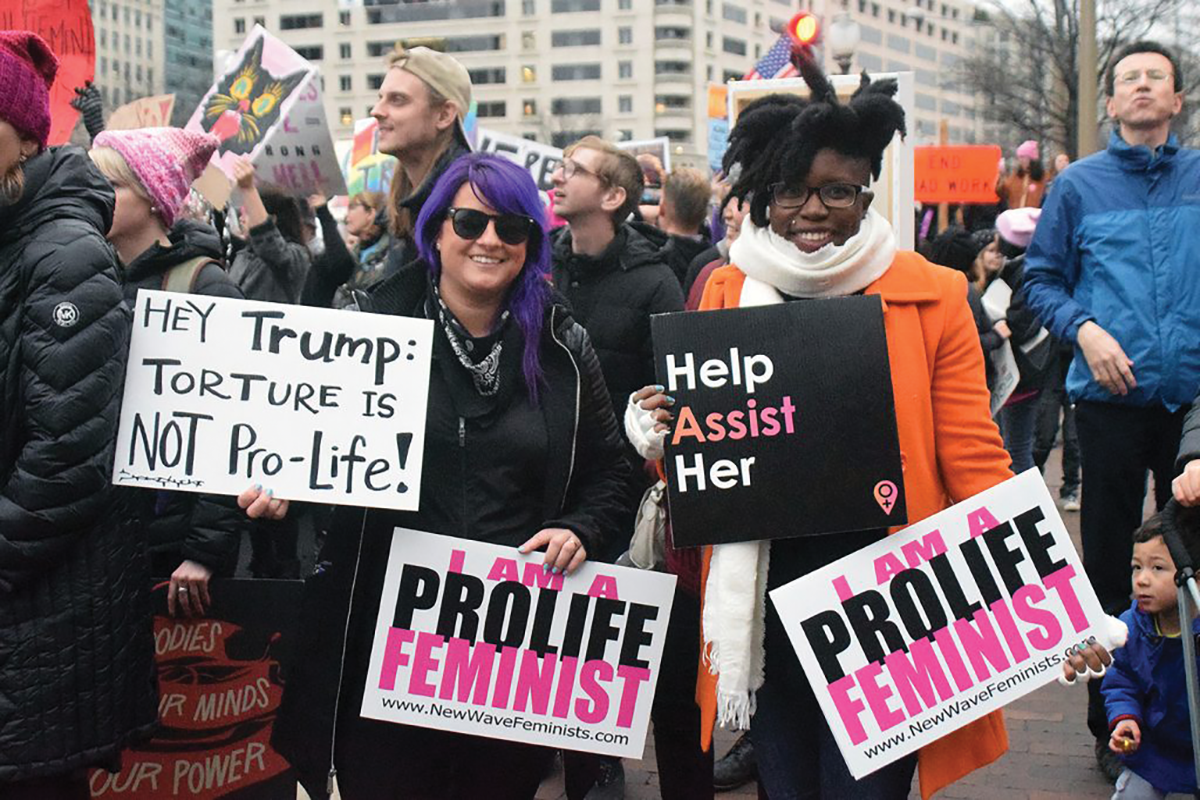
By Laura Strait, Doctoral Candidate, Media Studies, School of Journalism and Communication
As the topic of abortion restrictions grows more pressing in the public eye, an anomalous figure has emerged in a handful of high-profile press events. The pro-life feminists made their most notable appearance during the 2017 Women’s March following the inauguration of Donald Trump as president of the United States. In particular, the progressive pro-life activist group New Wave Feminists was rejected as an organizational member by march organizers in response to complaints by pro-choice participants. This public denouncement not only gave a platform and spotlight to pro-life feminism, but reopened an engagement between mainstream, institutional feminism, and the broader public.
This project looks to build a genealogy of the figure of the pro-life feminist as it evolved against a shifting sociopolitical backdrop, beginning with its early roots in progressive pro-life Catholic Democrats, but more importantly its tumultuous institutional emergence as a fracture from the National Organization for Women (NOW). As laws around abortion began to soften in the 1960s and NOW moved at the opportunity to position legalization as its top political platform, pro-life feminists were for the first time forced to decide between two ideological imperatives. NOW’s decision at the second annual convention in Washington, D.C., pushed many pro-life women to the margins, if not out of the women’s movement entirely. Some dramatically splintered off into the still prominent Feminists for Life of America (FFL), and have since straddled an uncomfortable line between the two communities.
I am interested in parsing out the specific details of this splintering, as well as the current dynamic of divide and the present instantiation of pro-life feminism. To this end, I am also deploying digital ethnographic methodology to map and analyze the online lives of pro-life feminists today. As it is a clear mode of organization, social media and related web platforms provide a space for planning, discourse, and the development of a group identity.
One of the draws to this topic stems from some unignorable parallels between pro-choice and pro-life feminists. What’s more, many arguments put forth by pro-life feminists echo various critiques of mainline feminism by dissenting groups (for instance, there has been, from the beginning of feminism in the United States, a divide between typically white and middle class constitutional feminists and lower class feminist groups concerned solely with labor and civil rights issues). The principal logic for pro-life feminists is the idea that abortion is a symptom of a society that failed women, through acts like stigmatization of single motherhood and young pregnancy, or a lack of workplace regulation around pregnant and nursing mothers. They frequently emphasize that communities of color are most likely to be targeted by abortion clinics and that females are, globally speaking, more likely to be aborted. These arguments are backed by an insistence that pro-life feminism is in fact the feminism of the first wave generation. Most controversially, Susan B. Anthony is frequently quoted as anti-abortion (this is how the Susan B. Anthony List originally came to be).
To build a comprehensive and critical history of pro-life feminism, I am conducting interviews with important actors in the movement, as well as archival research mainly at Radcliffe’s Schlesinger Library on the History of Women in America. In my archival work I am utilizing original documentation and letters that contextualize the personal and organizational ruptures of the early feminist movement’s decisions. This includes considering the role media play in constructing the popular memory of both the feminist movement writ large, and the pro-life movement at an integral time of its ideological conception. In June, I attended the annual Pro-Life Women’s Conference in Missouri to conduct interviews and better understand the pro-life feminist’s place within the larger pro-life movement. I quickly learned that the feminist sect of the pro-life movement occupied a conflicted place there as well.
To summarize, this project wrestles with the philosophical and social paradox of the pro-life feminist. Through qualitative methods including interviews, archival analysis, and digital ethnography, this project aims to read the space between the state, the home, and the political sphere to trace the extrinsic position that this identity marker occupies. With a critical historiography, I hope to contribute a deeper understanding of fringe social group development, and the role that both mass and social media play in building those groups’ identity, memory, and historical place among the larger public. The sustaining power of agitant social splinters within broader progressive and activist cultures can illuminate the boundaries and conflicts of those environments. In a broadening partisan gap in Western politics, close attention to groups that transgress intelligible sociopolitical boundaries might yet prove beneficial in grappling with incommensurable topics.
Laura Strait is the recipient of the 2018-19 CSWS Jane Grant Dissertation Fellowship.

